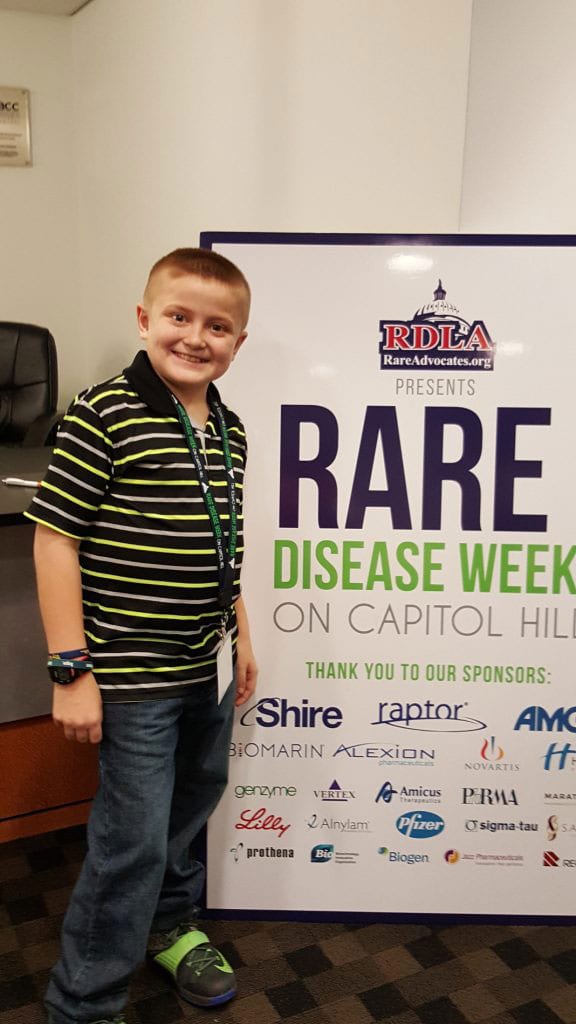2016 Rare Disease Week on Capitol Hill. Amid all the medical experts, pharmaceutical executives, patients and patient advocates, there’s a boy of 10. He sits quietly during the long hours, through meeting after meeting. Each break, the he gets up and tilts his head back to receive eye drops from his father’s pocket. He chats with two sweet young women who have cystinosis and smiles at everyone who wants to speak to him or take his photo. Briefly: A sweet-tempered and easy going child, a joy to be around! Meet Chandler.

Chandler Moore was 10 months old when his parents realized that he must be having a serious health problem. Sure, he was smaller than all the other kids his age, but that wasn’t what concerned them most. It was his sudden outbursts of extreme thirst. When his mother Annie took him to the grocery store and pushed him in the cart past a tower built with cases of water bottles, Chandler would begin to scream, reaching for the water. Chandler’s father Clint made a similar observation at home too: “If you were holding him and you got near the kitchen sink he would literally throw himself at it screaming,” he recalled in a recent video.
The immediate suspect for inexplicable thirst is diabetes, so Chandler’s pediatrician ordered lab tests to see if the little boy needed treatment for this not-so-rare disease. The results came back negative. Whatever it was that plagued this poor boy, diabetes wasn’t it. So the Moores were referred to Nemours and Alfred I duPont Hospital for Children in Wilmington, DE. For the next nine days, a battery of tests ensued; one doctor’s examination following on another’s. Finally, one doctor told Clint that his son had cystinosis: “I just know he does. I’ve seen this before.” Not many doctors ever get to see cystinosis, as it is so rare—only 500 Americans are thought to have it.
The bad news about Chandler’s cystinosis diagnosis is: it’s a very serious genetic condition which causes crystals of an amino acid, cystine, to accumulate in the organs.
Early cystinosis symptoms are frequent urination, excessive thirst, and fussiness.
The condition can lead to a host of complications, such as stalled growth, muscle wasting, difficulty swallowing, diabetes, thyroid issues, rickets, bone disease, and kidney failure. To avoid those, cystinosis patients undergo an extensive treatment regimen, and in most cases, an eventual kidney transplant is unavoidable. Obviously, cystinosis is impossible to hide from Chandler’s classmates.
Now here’s the good news: Today Chandler is a lively fifth-grader, going to Georgetown Elementary School. He can do almost everything his classmates are doing—except for football, which his bone disease has made impossible. “I’m treated the same as the other kids,” said Chandler. In fact, his mother Annie likes how his friends actively support him and remind him to take his medicine. “When I’m busy playing I just try to take (the pills) really fast so I can get back to playing,” Chandler explained.
Chandler is currently on 65 pills a day intended to mitigate some of the worst problems caused by cystinosis. Every six hours he needs to stop whatever he’s doing and take another handful. That includes having to wake up at 1 am every morning for some pills and going back to sleep until 7. On top of that, Chandler has to administer eye drops every hour. Occasionally, his bladder needs a catheter to ensure it stays empty and healthy. He used to need a feeding tube and growth hormones as well, but for now, none of that is necessary.
At first, nobody in Chandler’s family knew anything about cystinosis or anyone else who had it. This has changed dramatically, since his father Clint has become an active advocate for awareness and research funding. “I will never let an opportunity go to help a family or to raise awareness about the disease,” said Clint. Cystinosis is not only extremely rare, it’s also an invisible disease, which can pose its own challenges. Nobody would think of Chandler as a sick child just from looking at him.
“The Cystinosis families have been through so much that they can often give you answers a lot quicker than doctors can,” Clint explained.
When Clint traveled to Chicago last year to meet 84 other people with cystinosis at a conference, it amounted to the largest gathering of cystinosis patients in history. And knowing others who live with the same challenge is crucial.
As prominent advocates for patients with cystinosis, Chandler and his family travel to as many rare disease events they can, and the Patient Worthy team members are extremely grateful to have met these extraordinary and brave people. Thank you, Chandler, for being a champ for cystinosis!

Have people ever told you’re looking too good to really be sick? Share your experiences with the PatientWorthy community! Also, if you want to do more for the cystinosis community, you can support The Cystinosis Research Network. And don’t forget to check back in here soon.






